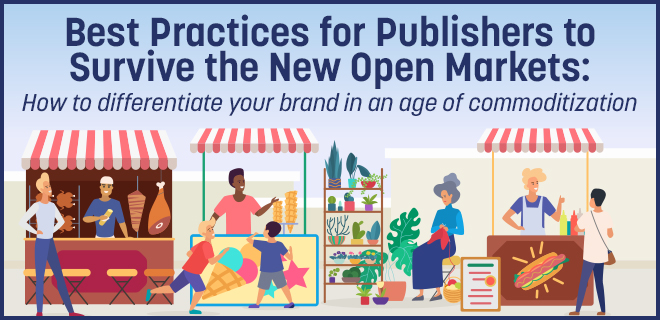
In today’s environment of consolidation and commoditization, it’s critical for publishers and tech platforms to differentiate themselves.
It’s no secret to everyone that the ad tech ecosystem has become highly commoditized. Much of the commoditization stems from the ease with which we white-label technology to spin up an ad exchange. And we’ve seen a proliferation of MFAs — aka websites that are manufactured for advertising (MFA) with the sole intention of engaging in ad arbitrage. This has led to a plethora of low-quality ad units in the open exchanges.
“In today’s environment, it’s critical to differentiate in some way shape, or form. The consolidation we’ve seen, and the rampant commoditization means publishers and tech platforms need to find a way to stand out,” advised David DiAngelo, Global Vice President of Marketplace Development at Emodo.
He recommends the following best practices for surviving in the new open markets.
#1: Think About Your Post-cookie Strategy
Cookie deprecation has been a hot topic since the moment Google announced it would cease to support third-party tracking cookies on Chrome. Several delays later, many publishers and tech platforms have come to believe that a cookie-less world isn’t something they don’t need to worry about. “A surprising number of publishers haven’t formulated a plan. This is a mistake because they need to know how they are going to monetize their business once this identifier finally goes away next year,” said DiAngelo.
In short order, however, publishers will need to find new ways to make advertising relevant to their users, so that it’s not a wasted ad unit. “As we lose data signals, publishers need to give serious thought to what the advertising experience looks like so that it’s still relevant for the consumer and the publisher’s marketing partners.”
#2: Think Native
According to an Emodo study, 76% of publishers that offer native inventory say it delivers better CPMs. Native ads also offer better experiences for the consumer and better performance for the advertiser. Creating native inventory doesn’t need to be a heavy lift for most publishers, as new technologies now allow any display ad to be converted to a native ad at the exchange level. If there isn’t a buyer interested in that native ad, it defaults to a display unit.
“The benefits to publishers go beyond higher CPMs,” DiAngelo said. “Converting display ads to native means the publisher can offer a far more consumer-friendly ad experience. It will match the look, feel, and function of the website and app, which will drive more engagement.”
This isn’t to say that publishers should only sell native ads, but they should find ways to ensure all their ads have the clean and friendly experience of native ads.
#3: Leverage Generative AI to Improve Ad Experiences Further
Once the publisher (or partner they work with) has created ideal ad environments, the next step is to up the quality of the ads. The combination of generative AI and creative dynamic optimization can lead to captivating advertisements that adapt to individual preferences and optimize their impact. The industry has talked about personalized advertising experiences for decades, but never really delivered it. Generative AI puts the goal within reach.
“Depending on the user and the scenario, we can start to do things like bring in animations to an ad if we see signals that the user would be open to it,” DiAngelo explained. “We can think about adding a pulsing call to action, or a different logo treatment, based on the individual user who sees the ad.”
#4: Know Your Audience
For decades we’ve talked about the importance of knowing your audience, but all too often those discussions addressed the needs of the consumer only. However, it is equally important for publishers to consider marketers as their audience. “The consumer experience and value of the content is obviously the publisher’s top priority, but that doesn’t mean that we can’t think about what would be valuable to marketing partners. The idea of creating engaging, high-quality content that your core audience appreciates and loves and understanding what is valuable to marketers does not have to be a mutually exclusive endeavor. Great and relevant advertising can enhance the reader experience,” said DiAngelo.
#5: Lean into Seller-Defined Audiences
Speaking of the consumer, publishers have a great deal of first-party data and knowledge of their audience demographics, interests, and behavior, and they should use that insight to create target segments. These segments will help their advertisers reach their desired audiences effectively.
Another interesting option is geo-location signals or location as intent. In other words, we measure engagement as intent, but there’s a big difference between visiting a website for an auto manufacturer and visiting a dealership. Location data — i.e. the presence of a mobile device at a dealership — is a stronger indication of intent.
#6: Update Your Partner Evaluation Process
Many publishers continue to evaluate partners based on relevant criteria from five or ten years ago. But the commoditization of the open markets means publishers need to work harder to find premium buyers, and that means they need to differentiate. Ask: can this partner help us differentiate our property? Are they offering innovations that will attract premium advertisers? Are they curating marketplaces that will drive CPMs and reduce fraud?
“We see a lot of SSPs that are plugged into the same DSPs, which means they’re not offering differentiated demand. Partners are instrumental in building audiences. If they’re not helping build audiences, they’re not helping the publisher to succeed in the post-cookie world,” said DiAngelo.
One final consideration: Does the SSP have a sales organization that is actively sourcing differentiated demand for the publisher? If not, find one that does. Collaboration in the new open markets is essential. If a publisher’s partner isn’t willing to work through problems with them, who will?